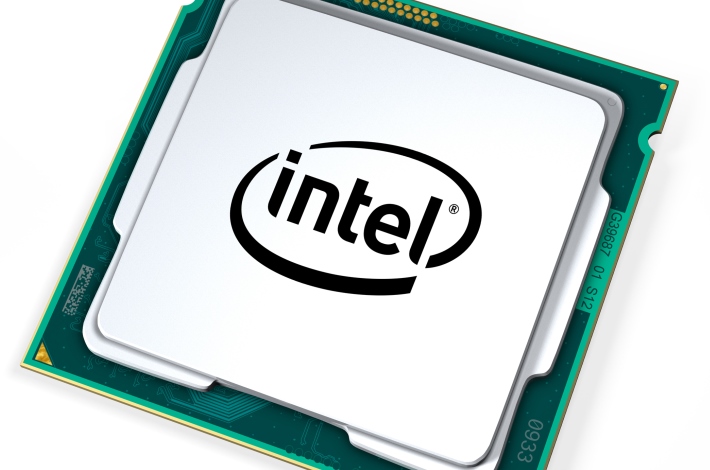For years the fabless chip makers seemed to have the upper hand as they designed their own semiconductors, but outsourced the actual manufacturing to others. In a new report, Jefferies makes the case that the integrated device manufacturers (IDMs) that design and manufacture their own chips are gaining market share and raising operating margins.
The Jefferies analysts note that between 2014 and 2016, the IDMs are expected to outgrow the fabless chip makers, reversing a decade-long trend. They say the change in operating margins, along with the firm’s “Moore Stress” thesis that transistor costs are inflecting at the leading edge after 40 years of consistent declines, favor the IDMs. What this also boils down to is the Jefferies team sees companies that they believe are directly poised to benefit from this new secular trend.
Intel
This top chip company has been in the doghouse on Wall Street all year, and the recent very positive earnings report has certainly helped to lift the investor pall hanging over the company. Intel Corp. (NASDAQ: INTC) is among those regarded as having among the highest shareholder cash returns at approximately 8%, but it has lagged high-growth specialty chip stocks. The iconic chip giant had a stellar 2014 on the tailwind from continued personal computer (PC) sales, but this year has been a far different story. Despite the positive second-quarter earnings report, the stock is down a gigantic 18.4% year to date.
Intel is purchasing chip rival Altera for a massive $16.8 billion. Some on Wall Street view the deal pessimistically, citing its high cost, aggressive growth assumptions on the part of Intel and the increase in debt. Others feel the addition will help Intel start to move away from the PC dependence.
ALSO READ: UBS Sees Top Tech Communications Equipment Stocks as Cheap Now
The Jefferies team notes that Intel’s pending acquisition of the company would put it into the traditional fabless market of programmable logic devices, but ultimately by 2020 50% of Altera’s product line could be manufactured at Intel facilities.
Intel investors are paid an outstanding 3.26% dividend. The Jefferies price target for the stock is $36. The Thomson/First Call consensus target is $33.87. Shares closed Monday at $29.10.
NXP Semiconductors
This company is considered a top play for investors looking for a chip stock with Internet of Things (IoT) exposure. The NXP Semiconductors N.V. (NASDAQ: NXPI) merger with Freescale Semiconductor was widely applauded on Wall Street, and many analysts believe the merger can transform the company into a powerhouse. The merger made NXP the fourth largest semiconductor company in the industry. It is also important to note that the combined company would be the number one supplier in auto semiconductors, number one supplier in global microcontrollers and a dominant supplier in mobile payments.
The company recently unveiled the industry’s most complete USB Type-C solution, including authentication and power delivery capabilities to further deliver secure connections. The authentication capabilities can be used to validate a device and determine whether specific functionality of that device should be enabled. This will maximize battery life and could prevent safety hazards or equipment damage from low-quality materials or noncompliant products. For example, detecting counterfeit power supplies before they are used for rapid charging functions.
The Jefferies price target is set at $116, and the consensus target is $120.33. The stock closed Monday at $90.01 per share.
ALSO READ: Why Intel Should Make a Bold Bid for Micron
Texas Instruments
This old-school chip tech company could be very well set further gains this year. Texas Instruments Inc. (NASDAQ: TXN) was the winner for the charging chipset solution that goes on the receive side of the new Galaxy GS6 phone, while another company won the transmit-side. The wireless charging solution is a good example of the company’s overall broad product portfolio.
Wall Street analysts point to the company’s outstanding intellectual property in all of the very hot IoT segment areas and wide distribution channels. Some have questioned whether the old chip giant with the main focus on analog and embedded processing technologies will make the move to embrace IoT technology and opportunity. If it does, that could be big.
Texas Instruments recently introduced the industry’s first current-sense amplifier to integrate a high-precision, low-drift shunt resistor, which can deliver highly accurate measurements over a wide temperature range. The company’s INA250 integrates the shunt resistor with a bidirectional, zero-drift current-sense amplifier to support both low-side and high-side implementations. Its accuracy and low drift reduce or may eliminate designers’ calibration effort for many systems. This integration also enables lower system cost and a smaller board footprint compared to competitive solutions.
Texas Instrument investors are paid a solid 2.75% dividend. The $65 Jefferies price target is well above the consensus objective of $56.39. The stock closed Monday at $50.09.
ALSO READ: 4 Top Jefferies Growth Stock Picks to Buy Now
Nvidia
This top company has started to make waves in the world of virtual reality. Nvidia Corp. (NASDAQ: NVDA) supplies graphics processing technology for the 3D graphics market, including desktop graphics processors and gaming consoles. Nvidia is also moving into visual computing chips for cars, mobile devices and supercomputers. Nvidia has a technology partnership with electric car maker Tesla, and the company has been able to use its ability to leverage past investments, with a more controlled spending structure ahead on unified, which enables strong cash flow that is allowing a focus on capital return.
While the bulk of Nvidia’s intellectual property revenues come from a licensing agreement with Intel, and some analysts have been concerned about the company’s exposure to the PC market and its decline this year, much of the company revenue growth is in the gaming arena. In fact, Nvidia dominates the graphic processor (GPU) space. GPUs are heavily utilized in the PC gaming market. While the PC market continues to shrink overall, the gaming-related growth continues sky-high.
Nvidia investors are paid a 1.95% dividend. The Jefferies price target is $22, and the consensus target is $22.68. The shares ended Monday at $19.70.
ALSO READ: 4 Large Cap Biotech Stocks to Buy Before Earnings
The advantage that the fabless companies used to enjoy has evaporated, and it looks likely to continue the decline. The top companies that design and manufacture their product are the stocks that aggressive tech investors should focus on.
Thank you for reading! Have some feedback for us?
Contact the 24/7 Wall St. editorial team.



